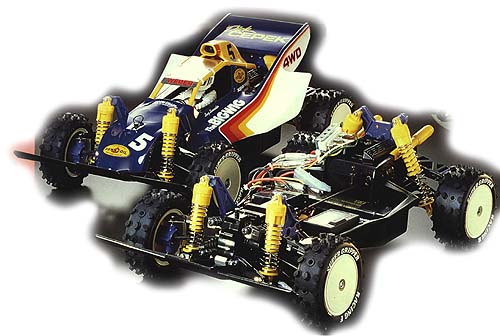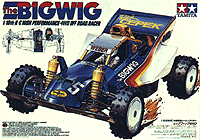Analysis of individual cars
The Big Wig (58057)

The BigWig was kit number 57 from Tamiya. A 1/10 scale 4WD off-road car, it was designed to commemorate the 10th anniversary of Tamiya's involvement in radio controlled cars.
Specifications:
- 1/10 scale off-road vehicle
- Shaft driven 4WD
- tub-type plastic chassis
- Fully independent suspension all around with drive cup/dog bone type setup
- Four high-capacity coil spring over oil filled dampers
- RS-540 Technigold motor
- Knobby/spike tires all around, rears slightly wider than fronts
- Unique lexan body
Description
This car was designed for all out speed and power. Unfortunately it had limited appeal due to a variety of reasons. Based on the Boomerang chassis the car has been modified to accept a new tub chassis that was wide enough to contain an 8.4V battery (one extra cell tagged onto the end).
As Tamiya cars go, construction was somewhat complex. This was primarily due to the fact that it was a four-wheel drive and one that relied upon an older drive train design: namely the HotShot. The gear boxes still relied upon C-rings to keep the inner drive cups in place. Which was not only a pain during construction but especially during "deconstruction" when the unit needed maintenance.
The BigWig is a very unique creature though and certainly worth a look. Despite some of its aging design, there were many elements of this car that are very unusual for a Tamiya of its era.
The car uses a unique rack and pinion style steering system that is not found on any other car before or after. It worked quite well so long as you ran a fast servo. It was a 1:1 ratio for steering
The lexan body was designed by famous real-car designer Takuya Yura. Yura was a leading Formula one car body designer at the time and it was considered a big thing to have him create the unique body for the BigWig. His logic for the body was simple. Given the small scale size of these cars, his intention was to try and make the entire car act like a large wing. This way the body itself would serve to provide the high-speed down force needed to maintain stability.
Unlike many other cars that Tamiya put out during that time which were little more that "badge engineering", the BigWig sported a lot of original pieces which were never seen again on any other. Items such as the moon dish wheels and chassis tub to subtle items such as the molded in engine valve covers to the "exhaust" pipes coming out of the rear. The BigWig succeeded in taking a rather old chassis and giving it a complete new and unique look on its own.
Unfortunately, none of this really helped its performance. A soft front suspension plus poor suspension travel meant that this car bottomed out on all but the smoothest off-road surfaces. It exhibited high levels of understeer, which was further aggravated by the slow rack and pinion. But the biggest problem (despite the powerful Technigold motor) was weight. This car weighed a R/C ton! Fully equipped with radio equipment and battery, the BigWig toppled the scales at just over 6lbs.
A wonderful looking car, but its performance is best exploited on flat smooth surfaces rather than true off-roading. If I had to compare the BigWig to a real size car, I'd have to say that it drives like a vintage Cadillac: powerful and boat-like in handling.
Historical Significance
 You would think that after reading all that, the BigWig would be a terrible car to collect. On the contrary, it's a very significant part of Tamiya's history. First and foremost, this IS the 10th anniversary car. And one which was wholly unique and not simply a re-decaling of something that already existed.
You would think that after reading all that, the BigWig would be a terrible car to collect. On the contrary, it's a very significant part of Tamiya's history. First and foremost, this IS the 10th anniversary car. And one which was wholly unique and not simply a re-decaling of something that already existed.
Second there aren't many of these around. In fact, I'd hazard to guess that with all the tooling costs involved, Tamiya probably took a loss on these things. For those that remember, the BigWig retailed for about $250.00 U.S. back in the late 80's when it debuted. Which would have been fine for a serious off-road car capable of winning races, but as a backyard basher (which was Tamiya's market back then) it was extremely expensive. Many retailers didn't even order one and for those that ordered them, they ultimately ended up on the discount shelf before they sold.
It's a milestone in Tamiya's history and one that will become increasingly more difficult to find in perfect condition.
Additional Notes
The BigWig originally came with a Technigold motor, these motors are very difficult to come by now so if the car you are buying doesn't have one it greatly affects its value. Make sure that the car you are purchasing has the Technigold and that it is in good working condition.
The very unique nature of this car also works against it when it comes to replacement parts. Numerous parts on this vehicle were unique to only this model and they're really hard to find. Everything from the rubber boots that cover the steering rods to the moon-dish wheels and the lexan body are all pretty hard to find brand new.
Luckily the drive train parts are mostly interchangeable with their most popular 4WD models of the time and that means that these parts are all pretty readily available. The only exception being the front gear box case. Because they were prone to crack on impact, these are usually the first parts to run out at the local hobby store. Actually the entire front suspension was prone to rapid wear. Slack in the front arms just gets worse over time and the steering knuckles snap with annoying regularity.
Rating
- Collectability - 8 out of 10
- Fun to drive - 6 out of 10
- Parts availability - 5 out of 10
